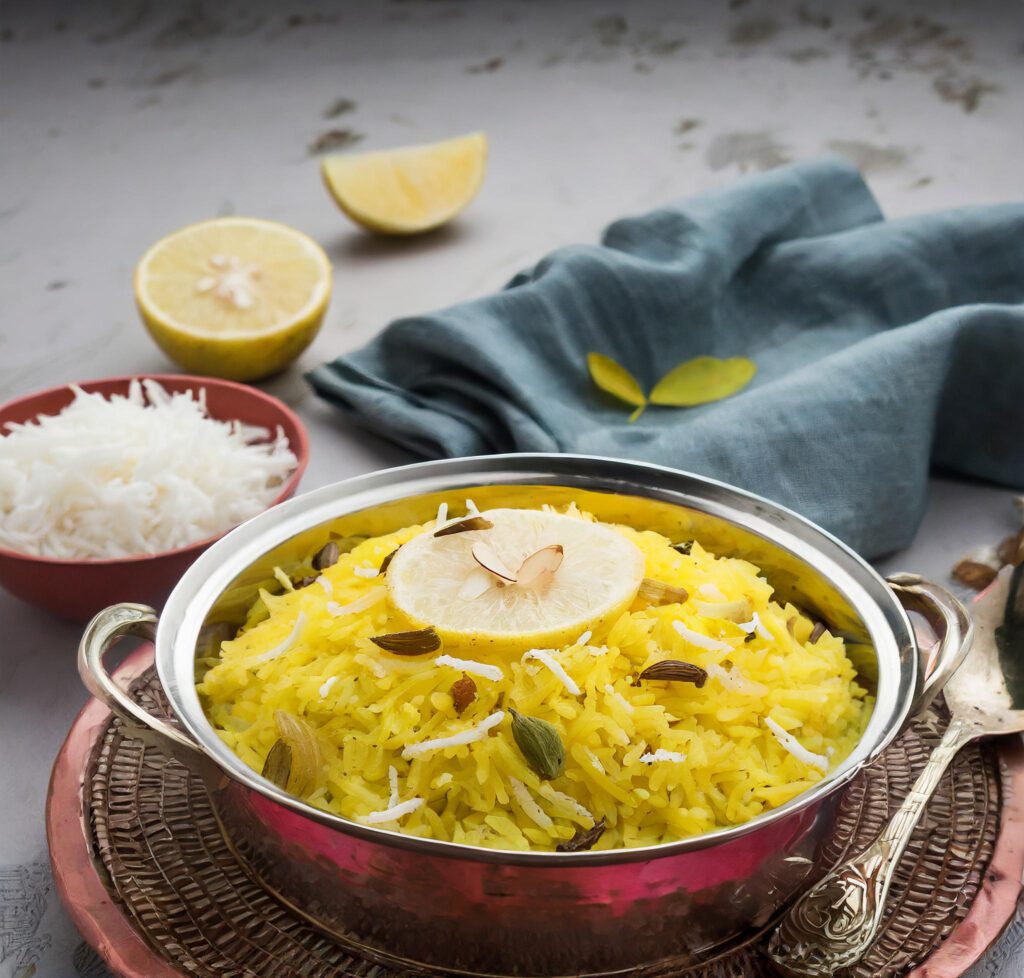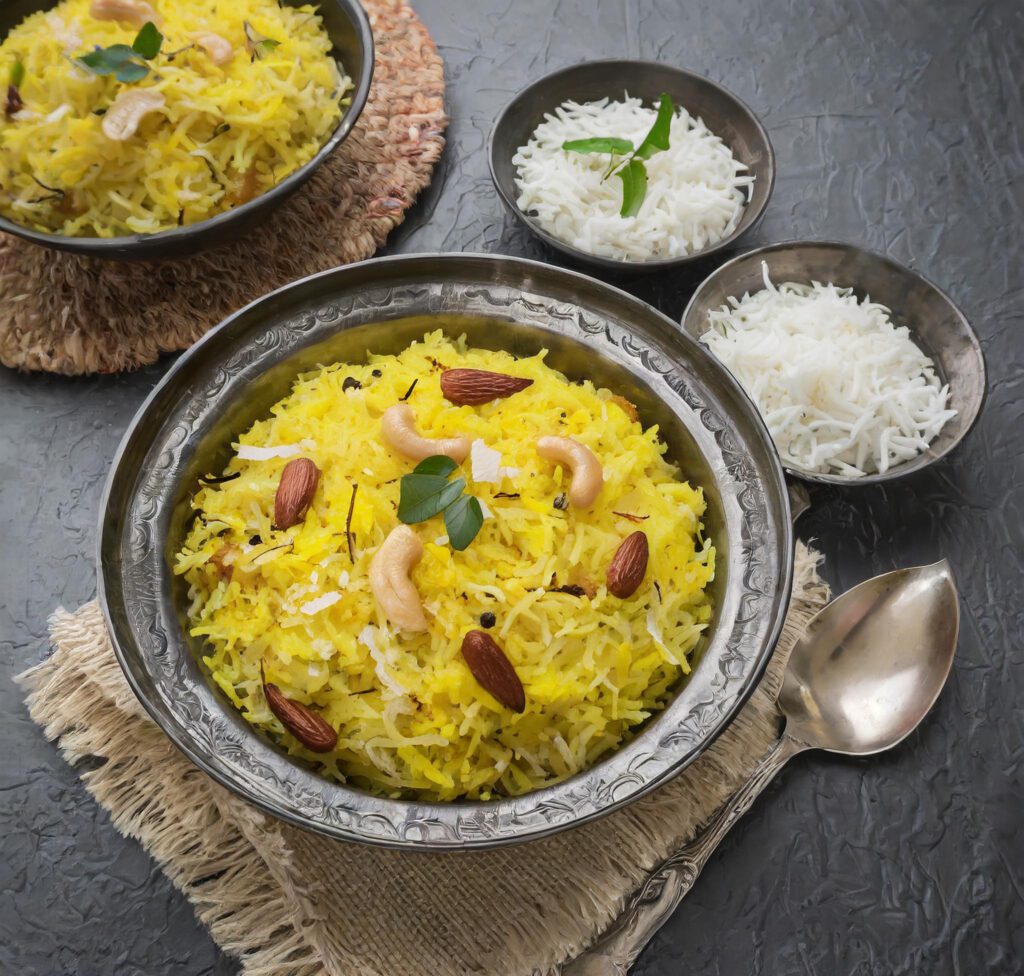Zarda, also known as Meethe Chawal or Sweet Rice, is a delicious and aromatic rice dish that has a particular place in the hearts of many people. Zarda, a traditional sweet delicacy from the Indian subcontinent, is frequently offered at festivals, weddings, and other special events. In this Zarda Recipe, we will delve into the beautiful world of Zarda, learning about its rich history, cultural significance, and, of course, the delicious recipe that has been passed down through centuries.
Understanding Zarda: A Sweet Tradition.
Zarda is more than just a dish; it is a representation of celebration and community. Zarda, a culinary masterpiece made of fragrant Basmati rice, ghee (clarified butter), sugar, and a variety of nuts, dried fruits, and aromatic spices, tantalises the taste senses while also warming the soul. Zarda’s rich colours, produced through the addition of saffron and food colouring, enhance its visual attractiveness while also providing a feast for the eyes.Let us begin with the Zarda Recipe.
Zarda Recipe

Ingredients for Zarda Recipe:
1 cup Basmati rice
1/2 cup sugar (adjust according to taste)
4 cups water
1/4 cup ghee (clarified butter)
A pinch of saffron strands
A handful of mixed nuts (cashews, almonds, pistachios)
A handful of mixed dried fruits (raisins, chopped dates)
4-5 green cardamom pods
A few strands of food coloring (optional)
Step by Step Guide for Zarda Recipe:
Step 1: Wash and Soak the Rice
Start by rinsing the Basmati rice under cold water until the water runs clear. Then soak the rice in water for 30 minutes to an hour. This softens the rice and ensures it cooks evenly.
Step 2: Prepare the Flavorful Base
In a large pot or deep saucepan, heat the ghee over medium heat. Sauté the green cardamom pods for a few seconds, until fragrant. Then, add the mixed nuts and dried fruits to the pot and cook until softly golden brown.
Step 3: Cook the Rice
Drain the soaked rice and add it to the pot with the nuts and dried fruits. Stir carefully to coat the rice with the ghee and aromatic spices. Next, heat the water in the pot until it boils. Once boiling, decrease the heat to low, cover the pot, and let the rice simmer for 15-20 minutes, or until fully cooked and fluffy.
Step 4: Add the Sweetness
Once the rice is cooked, add the sugar to the pot and stir well to dissolve it. You can vary the amount of sugar to suit your tastes. To enhance the flavour, add a pinch of saffron strands soaked in warm milk to the saucepan.
Step 5: Infuse with Color
If desired, add a few strands of food coloring to the pot and gently mix them into the rice. This step is optional, but it gives a brilliant colour to the Zarda, making it more visually appealing.
Step 6: Garnish and Serve
Once the sugar has dissolved and the Zarda is cooked to perfection, remove it from the heat. Garnish the Zarda with more nuts and dried fruits for an added burst of flavour and texture. Serve Zarda warm or at room temperature, with your favourite savoury dishes or as a standalone dessert.

1. Cultural significance: Zarda is a popular dish in Indian and Pakistani cuisine, especially during festivals like weddings, Eid, and Diwali. It is frequently offered as a customary dessert for guests and family members, representing hospitality, warmth, and generosity.
2. Historical Roots: The origins of Zarda can be traced back to the Mughal era, where it was considered a royal delicacy and served in the courts of Mughal emperors. It grew in popularity over time, eventually becoming a cherished sweet dish relished throughout the Indian subcontinent.
3. Variations and Regional Influences: While the basic recipe for Zarda remains consistent, there are regional variations in terms of ingredients and preparation methods. Zarda, for example, is created in certain locations using rice, sugar, ghee, and nuts, whilst in others it may incorporate khoya (reduced milk solids), rose water, and edible silver or gold foil for garnishing.
4. Health Considerations: While Zarda is undeniably delicious, it is important to consume it in moderation due to its high sugar and calorie content. Zarda can be made more nutritious by substituting natural sweeteners like honey or reducing the amount of sugar used. Incorporating nuts and dried fruits also increases nutritional value by providing protein, fibre, and vital vitamins and minerals.
5. Symbolism and Rituals: In addition to its culinary significance, Zarda often holds symbolic meaning in cultural and religious rituals. For example, it could be used as a sacred offering during prayers or as prasad (blessed food) at temples and religious gatherings. The act of preparing and sharing Zarda with loved ones is viewed as a symbol of love, respect, and unity.
6. Modern Twists and Innovations: While traditional Zarda recipes remain timeless classics, modern chefs and home cooks often experiment with innovative twists and flavor combinations. To produce distinct varieties of this renowned sweet dish, ingredients such as saffron, rose water, and cardamom can be added, as well as exotic fruits like mango or pineapple.
Zarda is more than a dish; it is a labour of love that brings people together and fosters enduring memories. Zarda, whether savoured during festive events or cherished family gatherings, never fails to captivate the senses with its seductive perfume, brilliant colours, and tempting sweetness.
With this easy yet exquisite Zarda Recipe, you can bring Zarda’s magic into your own home and share its warmth and joy with those you love. So, why not go on a gastronomic excursion and enjoy the delicious flavours of this traditional sweet dish by this Zarda Recipe? Your taste buds will appreciate you!
You can also try some Quick and Delicious Pasta Recipe: 30-Minute Pasta Recipes for Busy Nights.
Pingback: Ragi Idli Recipe: Healthy Twist to Traditional Breakfast 2024